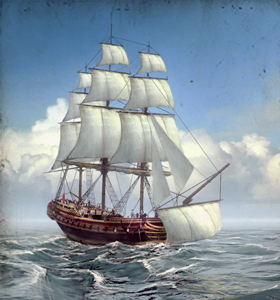|
|
|||
|
|
|
|
|
|
|
|||
HMS CHALLENGER 1826-1835
|
|
|
|
|
|
WE NEED YOUR SUPPORT. |
|
|
|
|
The HMS Challenger was launched in at Portsmouth in 1826 as a 28 gun sixth rate frigate.
Sixth Rate was a designation used by the Royal Navy for small warships that usually had one main deck of guns with sometimes smaller cannon mounted in upper deck works. Crews varied from 150 to 240 men, 19 of which would have been officers. These ships weighed between 450 and 550 tons.
The Challenger was a larger Sixth Rate ship and was classed as a frigate. Smaller Sixth Rate ships were known as Post Ships.
Just over 125 feet long and 33 feet wide her armament consisted of twenty 32 pounders, six 18 pounders and two 9 pounders.
The ship was under the command of Charles Fremantle during the creation of the colony at Swan Rover (Perth).
The ship was wrecked on May 19th 1835 off the coast of Chile while under the command of Capt. Michael Seymour.
This ship should not be confused with others of the same name that served with the Royal Navy. At one time we had a
picture displayed of HMS Challenger that on further research we found to be a later version of the ship. As far as we know,
there is no picture of the ship that was involved with the settlement of Western Australia.
The naval database contains the following information about HMS Challenger and her career:
25 May 1827 arrived Spithead with the experimental squadron, having spent a month at sea, during which they performed trials relative to the sailing qualities of the various ships They are ordered to take on stores for foreign service in preparation for a further cruise.
16 Jun 1827 remains at Spithead.
4 Jun 1827 Reports received that the Experimental squadron has been performing trials to test the sailing qualities of the various ships of the squadron.
15 Sep 1827 Is fitting out at Portsmouth for foreign service for a third cruise with the Experimental Squadron and is expected to go down to St. Helen's Monday next, weather permitting.
25 Sep 1827 departed Portsmouth with Experimental Squadron for off Scilly.
5 Apr 1828 remains Lisbon to look after British interests.
25 Jun 1828 preparing at Portsmouth for a passage for Newfoundland, Halifax, and Quebec.
15 Dec 1828 Performing sailing trials off Plymouth, with the Pallas.
15 Oct 1829 reported to be off New South Wales.
15 Oct 1829 reported to be off New South Wales.
22 May 1830 reported to be in the harbour at Bombay.
23 Sep 1830 arrived Bombay from Bushire.
21 Oct 1830 arrived Bombay from Surat.
16 Dec 1830 departed Bombay for Malabar.
9 Apr 1831 arrived at Bombay.
28 May 1831 arrived at Madras from Bombay.
13 Sep 1831 arrived Calcutta from Madras.
29 Sep 1831 departed Bengal for China.
16 Mar 1832 departed China.
27 Mar 1832 arrived Singapore from China, and departed the following day for Bengal.
17 May 1832 departed Calcutta for Madras and Trincomalee.
9 Jun 1832 departed Madras to refit at Trincomalee.
9 Jul 1832 arrived Madras from Ceylon.
1 Aug 1832 had departed for Swan River.
15 Oct 1832 arrived Sydney, from Madras, and Swan River.
11 Nov 1832 departed Sydney for the South Sea Islands and Valparaiso.
16 Apr 1833 departed Rio de Janeiro for Portsmouth.
30 May 1833 arrived Spithead, from Rio de Janeiro, having previously called at Madras, the Swan River settlement, Hobart Town, Sydney, New Zealand, Otaheite, and Pitcairn Island.
8 Jun 1833 In Harbour Portsmouth.
12 Jun 1833 paid off.
15 June 1833, Portsmouth, commissioned.
28 Aug 1833 Portsmouth, undocked.
20 Sep 1833 Portsmouth, taken out of the basin and preparing for a passage to South America.
16 Oct 1833 departed Portsmouth but later returned due to the gale.
19 Oct 1833 departed Portsmouth for South America.
21 Dec 1833 departed Rio Janeiro for the Falkland Islands.
19 Jan 1834 nearing Cape Horn, in a boating accident an officer, the purser's steward, and two seamen were drowned.
16 Feb 1834 refitting at Valparaiso.
13 Jun 1834 collecting freight from Callao.
10 Oct 1835 a court martial will be held onboard the Victory, at Portsmouth, tender to the Britannia, on Monday next, to try the officers and crew of the Challenger, wrecked on the coast of Chili in May.
|
|
Become a supporter of this website for just $5 a month
|







